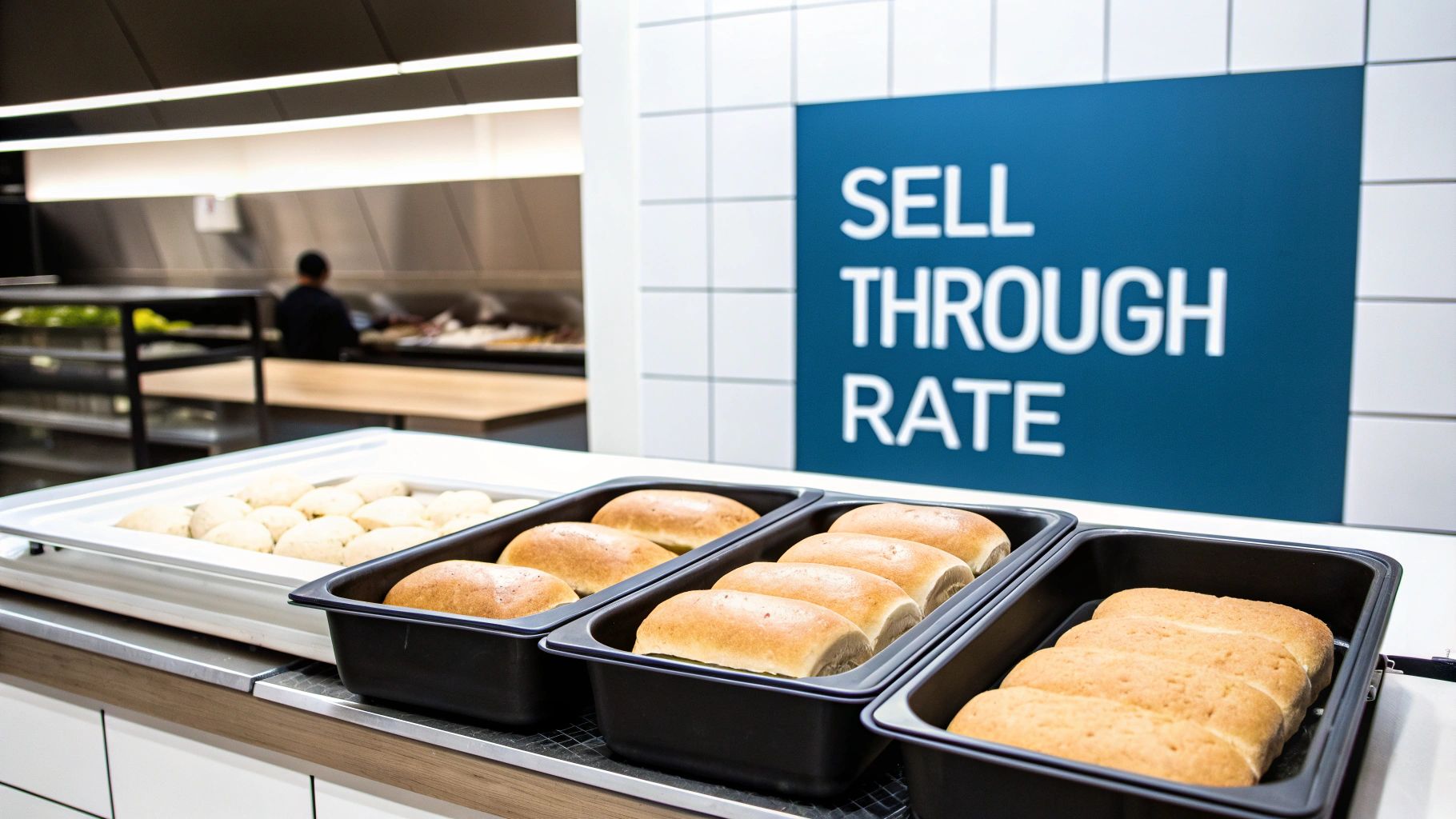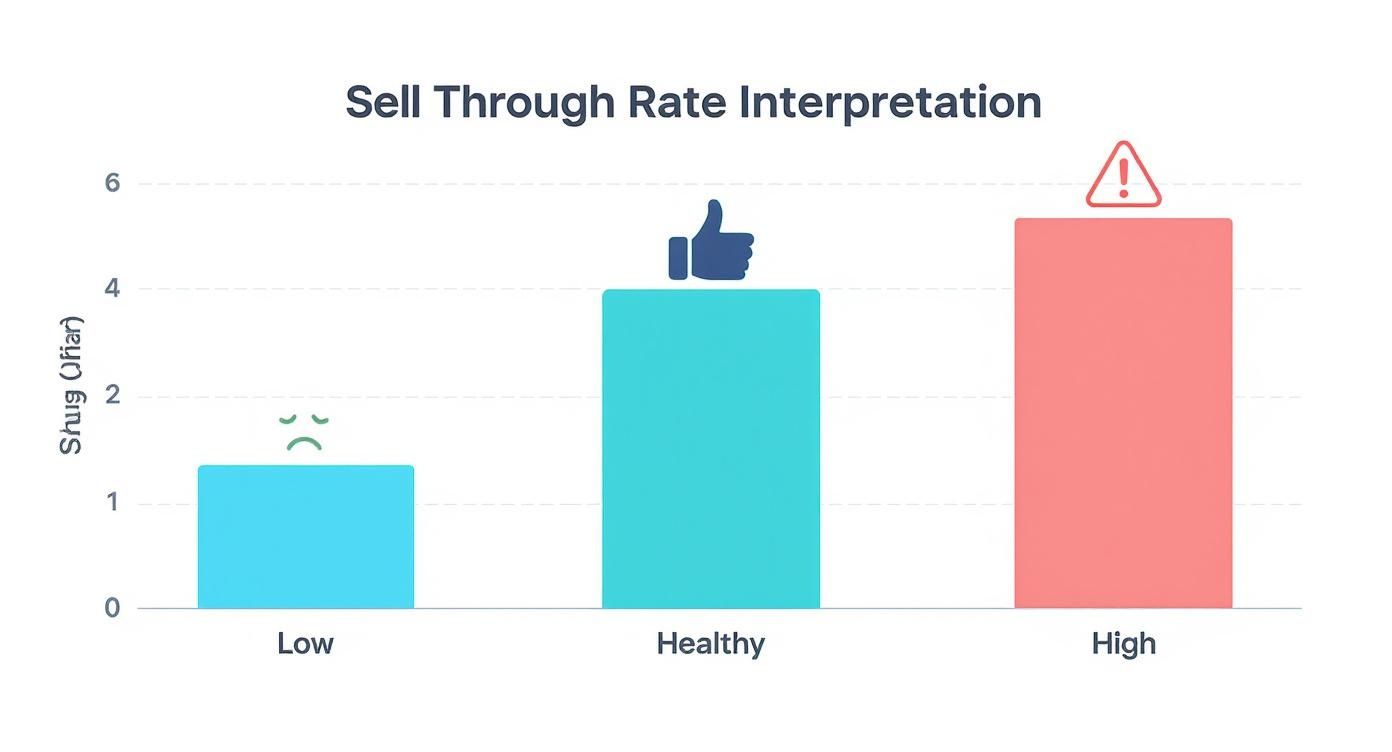Stay Updated with Everything about MDS
Thank you! Your submission has been received!
Oops! Something went wrong while submitting the form.

Chilat Doina
November 6, 2025
Here's a little secret from the trenches of retail: one of the simplest numbers can tell you the most about the health of your business. That number is the sell through rate.
Think of it as the percentage of inventory you’ve actually sold compared to the total amount you brought in from your supplier. It’s a gut check, a reality check, and a crystal-clear answer to one burning question: Are people buying what I’m selling?
Let's ditch the jargon and get practical. Imagine you run a small-town bakery. Every morning, you bake 100 fresh loaves of sourdough. By closing time, you’ve sold 80 of them. That’s an 80% sell through rate. What does this simple figure tell you? A lot, actually. It says your bread is a hit, you’ve nailed your daily demand, and you're turning flour and yeast into cash efficiently.
Now, flip the script. What if you only sold 20 loaves? A 20% sell through rate is a glaring red flag. Maybe you baked way too much. Maybe your price is off. Or maybe your customers just don't know your sourdough exists.
That’s the power of this metric. It’s a direct measure of how fast your products are moving and how smart your inventory management is. A high rate feels great—products are flying off the shelves, cash is flowing in, and your buying instincts are on point.
A low rate, however, points to problems that quietly drain your bank account:
At its core, sell through rate is just the percentage of inventory you sold versus what you received over a certain period. If you got a shipment of 1,000 widgets and sold 700 in a month, your sell through rate is 70%. Keeping an eye on this number is absolutely essential for avoiding a warehouse full of unsold goods and keeping your cash flow healthy. If you want to dig deeper, the folks at Toolio.com offer some great insights on how to calculate and optimize it.

The math itself is incredibly straightforward, but the story it tells is profound.
The Fundamental Formula:Sell Through Rate (%) = (Number of Units Sold / Number of Units Received) x 100
To make it even easier, here's a quick reference table.
ComponentDescriptionExample ValueUnits SoldThe total number of items sold during a specific time period.750 T-shirtsUnits ReceivedThe total number of items you received from your supplier at the start of that period.1,000 T-shirtsCalculation(Units Sold / Units Received) x 100(750 / 1,000) x 100ResultYour sell through rate for that period.75%
This simple calculation gives you an immediate, powerful snapshot of how a product is performing. When you start tracking it regularly, you stop guessing and start making sharp, data-driven decisions that have a real impact on your bottom line.
Alright, let's move from theory to action. This is where you turn raw data into smart decisions. Figuring out your sell through rate is actually pretty simple, but the real magic is in understanding what those numbers are telling you about your business and what your customers truly want.
To get started, you just need two key pieces of information: the units sold and the units you received (or your starting inventory) for a specific time frame. You can pull this data straight from your Point of Sale (POS) system or whatever inventory management software you're using. Just run a report for a particular product or category over the last month, and you'll have what you need.
Once you've got your rate, you need to add some context. A number floating in space is just a number. It's the story behind it that helps you build a winning strategy. A high rate isn't automatically a win, and a low rate isn't always a disaster.
Think about these two very different scenarios:
Interpreting the rate means looking beyond the percentage. You have to consider where a product is in its lifecycle, seasonality, and what your overall business goals are.
A common mistake is to treat sell through rate like a simple pass/fail grade. A much better approach is to see it as a diagnostic tool. It helps you start asking the right questions about your inventory, pricing, and marketing.
While sell through rate is a powerful snapshot of your sales velocity, it's not the whole story. For a complete picture of how efficiently your inventory is working for you, it helps to look at related metrics. For example, learning how to calculate your inventory turnover ratio gives you a broader view of how many times you sell and replace your entire stock over a year.
Ultimately, what counts as a "good" sell through rate is completely dependent on your industry and your goals. A high rate might feel great, but if it means you're constantly out of stock, you're leaving money on the table and frustrating customers. On the flip side, a consistently low rate is a clear warning that your purchasing strategy is out of sync with what people actually want to buy, leading to wasted capital and shrinking profits.
Pinning down a universally “good” sell through rate is a bit like trying to agree on the perfect room temperature—it really just depends. A number that screams success in one industry might be a red flag in another. There’s no single magic number; the ideal rate is a moving target shaped by your market, your products, and your business model.
Think about it: a fast-fashion retailer has to move inventory at lightning speed to keep up with trends. For them, a high sell through rate is basically a survival metric. On the other hand, a shop selling high-end TVs expects a much longer sales cycle, so a lower, steadier rate is perfectly healthy. It all comes down to context.
The real key is to measure your performance against relevant standards, not some generic, one-size-fits-all number. A healthy rate strikes that perfect balance between meeting customer demand and not getting buried under a mountain of unsold stock.
If your rate is too high, you might actually be understocked and leaving money on the table. Too low, and your cash is just sitting on a shelf collecting dust.
This infographic does a great job of showing that sweet spot between a poor, healthy, and potentially risky sell through rate.

As you can see, the goal isn’t just to hit a high number. It’s to find a sustainable rate that avoids both the cost of overstocking and the frustration of stockouts.
As a general rule of thumb, many ecommerce stores aim for a monthly sell through rate between 60-80% to stay profitable. This range helps them align their purchasing with how fast products are actually selling. For example, fashion brands often shoot for 65-70% because of seasonal changes, while electronics might target 50-60% due to longer product lifecycles.
Brands that consistently dip below 30% are usually heading for trouble, facing expensive holding costs or having to slash prices just to move product. You can dig into more stats on what sell through rates ecommerce brands are aiming for to get a better feel for your specific niche.
Beyond your industry, a few other things can move the goalposts for your target sell through rate. Getting a handle on these nuances is crucial for judging your performance accurately.
At the end of the day, a "good" sell through rate is one that keeps your cash flow healthy, your carrying costs low, and accurately reflects what your customers want to buy. It's a living, breathing metric you need to track and adjust based on what's happening in the real world.
It’s easy to think of your sell through rate as just another number on a spreadsheet, but it’s actually a vital sign of your business's financial health. When that number is off, it starts to quietly bleed cash from your bottom line in ways that aren't always obvious. A bad rate—whether it's too low or surprisingly high—creates some serious hidden costs that can put the brakes on your growth.
A low sell through rate is the classic problem, and it's so much more than just having "dead stock" lying around. Every single unsold item is actively costing you money.
When your products just sit there, your capital is frozen solid. That cash, which you could be using to fund new product ideas or pump into your marketing, is instead gathering dust on a warehouse shelf. But the bleeding doesn't stop there. You're also paying for:
These costs pile up over time, creating a massive financial drag. A consistently low rate isn't just inefficient; it's a direct threat to your profitability.
On the flip side, a sky-high sell through rate isn't always the big win it appears to be. Sure, it means demand is strong, but a rate creeping up toward 100% is a huge red flag. It usually means you're understocked and leaving a ton of money on the table. The biggest cost here? Lost sales. When a customer shows up ready to buy and sees "out of stock," that revenue is gone for good.
A sell through rate that’s too high can be just as damaging as one that’s too low. It points to missed opportunities, frustrated customers, and potential damage to your brand's reputation for reliability.
The fallout from a stockout is bigger than just one lost sale. It can frustrate customers who might just head over to your competitor—and they might not come back. That kind of experience chips away at brand loyalty and can hurt your growth in the long run.
In the past, getting close to a 100% sell-through might have seemed like the ultimate goal, but it often just highlights supply issues and missed opportunities. Both extremes have serious financial consequences. Too much inventory ties up your working capital and drives up costs, while constant stockouts mean you're walking away from guaranteed revenue. If you want to dig deeper into these inventory dynamics, you can discover more insights on InflowInventory.com. Improving your rate, even by just a few percentage points, can unlock a surprising amount of profit and drastically improve your cash flow.

Understanding your sell through rate is one thing; actually improving it is where the magic happens for your bottom line. A healthy rate isn't something you stumble into by accident. It’s the direct result of smart, deliberate strategies that perfectly align your inventory with what your customers are dying to buy.
Luckily, there are plenty of proven ways to get your products flying off the shelves faster. These tactics cover everything from nailing your initial purchase orders to launching clever marketing campaigns. The goal is to build a nimble system that keeps dead stock at bay and pushes sales velocity to the max.
Let’s be honest, the single best way to boost your sell through rate is to get your ordering right from the get-go. Over-ordering is the number one culprit behind low rates, tying up your cash and forcing you into profit-killing markdowns. Your best defense? Pinpoint-accurate demand forecasting.
Start by digging into your historical sales data. Look for the hidden stories in seasonality, product lifecycles, and emerging consumer trends. Don't just go with your gut when you have hard data that can paint a much clearer picture.
A classic mistake is re-ordering the same quantity just because a product sold out. Instead, look at the sales velocity—how fast it sold. That tells you whether to order more, less, or the same amount to meet the next wave of demand without getting stuck with leftovers.
When you make purchasing decisions based on data, you’re lining up your supply directly with what people are actually going to buy. This proactive mindset is the foundation of a consistently great sell through rate. For a deeper dive, exploring different inventory forecasting methods can give you a serious competitive edge.
Your pricing strategy is a powerful lever you can pull to control how fast your inventory moves. If a product is just sitting there with a sluggish sell through rate, a well-timed promotion can be the jolt it needs to wake up sales. And no, this doesn't always mean slashing prices and destroying your margins.
Think more tactically:
Sometimes a product isn't selling for a painfully simple reason: the right people don't even know it exists. Targeted marketing campaigns can breathe new life into items that are gathering dust. Figure out who the ideal customer is for that slow-moving product and hit them with campaigns on the channels they actually use.
Also, take a hard look at how the product is presented. Good merchandising—both online and in-store—is a game-changer. On your website, that could mean better product photos, keyword-rich descriptions, or a feature on your homepage. On marketplaces like Amazon, focusing on optimizing your conversion rate can massively impact how many browsers become buyers. After all, poor visibility is a much easier problem to fix than a bad product.
Below is a quick-glance table to help you connect these strategies to the core parts of your business they influence.
StrategyPrimary Business FunctionExample TacticDemand ForecastingInventory ManagementAnalyze historical sales velocity before reordering.Pricing & PromotionsSales & MarketingBundle a slow-moving item with a popular product.Visibility & MarketingMerchandising & AdvertisingRun a targeted social media ad campaign for a specific product.Conversion OptimizationE-commerce/SalesImprove product page images and copy.
Each of these strategies offers a different lever to pull. By understanding which part of your business each one impacts, you can choose the right tactics to get your inventory moving and your profits growing.
Getting a handle on your sell through rate isn't just about crunching another number. It's about fundamentally changing how you look at your inventory. This is a constant cycle: calculate the rate, figure out what it's telling you, and then make smart, targeted moves to get better.
The real goal here is to stop reacting to stock levels and start proactively managing the health of your inventory. When you do that, what was once just a cost center on your balance sheet transforms into one of your biggest strategic advantages.
Consistently tracking and acting on your sell through rate is how you build a more resilient, efficient, and ultimately more profitable business from the ground up.
Think of this guide as your starting line. Mastering this one metric is a huge first step toward running a tighter ship. If you're ready to dive deeper and see a direct impact on your bottom line, these small business inventory management tips are a fantastic next read.
By putting what you've learned into practice, you’ll start making better buying decisions and freeing up cash that was previously tied up on your shelves. For a complete playbook, check out our guide to inventory management best practices, built specifically for serious sellers looking to scale their operations.
Even after you get the hang of the basics, a few practical questions always seem to pop up when you start applying sell through rate in the real world. Let’s tackle some of the most common ones to firm up your understanding and get you using this metric with confidence.
While the "right" number changes from one industry to another, a healthy benchmark to aim for is somewhere between 60% and 80% each month.
If you’re consistently hitting above 80%, it might actually be a sign that you're understocking and leaving money on the table. On the flip side, a rate dipping below 40% is often a red flag for overstocking or a product that just isn't resonating with customers.
The best cadence really depends on your sales cycle. If you're in a fast-paced niche like fashion, you'll want to be checking this weekly or bi-weekly to keep up with trends. For businesses with a longer product life, like furniture or high-end electronics, a monthly or even quarterly calculation will give you the insights you need.
The most important thing is to be consistent. Pick a timeframe that makes sense for your business and stick to it. That's how you spot trends, compare performance over time, and make smart, proactive tweaks to your inventory plan.
It's easy to get these two mixed up, but they tell you very different stories about your business.
Think of it this way: sell through is your tactical, product-level check-in, while turnover is your strategic, big-picture health assessment. You need both to get a complete view of how well your inventory is working for you.
Ready to join a community that lives and breathes these kinds of metrics? Million Dollar Sellers is an exclusive network for top e-commerce entrepreneurs who share high-level strategies for scaling smarter. Connect with founders who have already mastered inventory, marketing, and operations.
Apply for membership at Million Dollar Sellers
Join the Ecom Entrepreneur Community for Vetted 7-9 Figure Ecommerce Founders
Learn MoreYou may also like:
Learn more about our special events!
Check Events